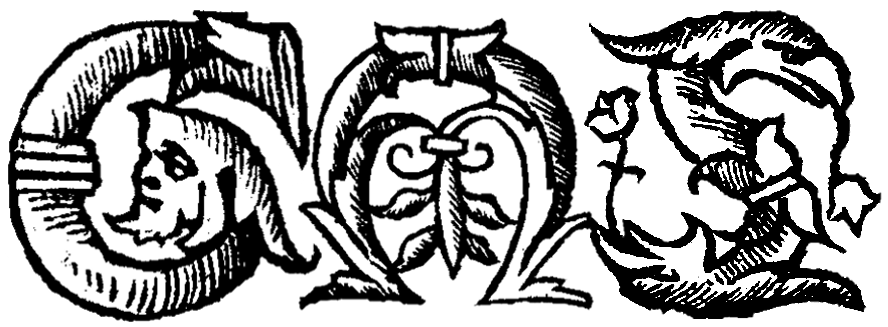The Gosling | Daz Genselin
Introduction to the Text
The Gosling is a typical example of the Middle High German tradition of mären: short narrative texts written in rhyming couplets, often telling humorous stories spiked with sexual jokes and sideswipes against specific social groups, most frequently clerics. In this way, mären are similar to the French fabliaux and the Italian prose novelle.
The Gosling was probably composed in the second half of the thirteenth century CE, and its author is unknown. The text tells the story of a young monk who leaves his monastery for the first time, encountering an outside world about which he is entirely ignorant. Never having seen a woman before, he innocently asks his abbot about those that they meet, and the abbot, trying to suppress the monk's instant fascination, tells him that these creatures are called “geese”. The abbot's plan fails as the naive monk is soon seduced by a village girl. Unaware of his wrongdoing, he reveals his sexual encounter to the abbot, who recognizes the calamity caused by his white lie.
The motif of the young man inexperienced in the ways of the world is widespread in European medieval literature. It is central to the various medieval versions of the legend of Barlaam and Josaphat (for example, Rudolf von Ems's Barlaam und Josaphat, also in Middle High German, composed c.1220/30) and is frequently used as a moral anecdote in sermons and exemplary literature (for example, Jacques de Vitry's Exempla, no. 82). Although commonly found in texts intended to educate their listener, the motif's humorous potential did not escape medieval authors and audiences and there are a large number of burlesque medieval stories about young men who have never seen women before and yet are instantly attracted them. For example, both the early fourteenth-century Italian text Novellino (specifically story no. 14) and Giovanni Boccaccio's Decameron (composed in 1358; see specifically the introduction to the fourth day) tell variants of this story.
The Gosling is a relatively early example of this narrative tradition. With regard to its verse form, sexual humor and undertones of anticlericalism, it represents central characteristics of the mären tradition and provides an introduction this literary genre.
Introduction to the Source
Multiple variants of this text are transmitted in six manuscripts that were written between the early fourteenth and mid-fifteenth centuries CE. The manuscript that our translation is based on was composed in Würzberg (in what is now southern Germany) around the year 1350 CE. In the scholarship, it is known as manuscript E.
Please note: You will see that the manuscript images embedded in the text panel (if you click “Go to Text”) do not always match our edition of the medieval text. This is because these images are not of manuscript E (which has not yet been digitised), but of a slightly earlier manuscript which also contains The Gosling: Heidelberg Cod. Pal. germ. 341. This manuscript is available to view in its entirety here. Although the two manuscripts generally agree, there are some variations. This is a common feature of medieval texts, which are often slightly modified when they are recopied, whether by mistake (i.e. when the scribe makes an error) or deliberately (i.e. when the scribe makes an alteration).
About this Edition
We have translated The Gosling according to Klaus Grubmüller's edition of manuscript E (Munich, University Library, 2° Cod. ms. 731, fol. 91v–93v). His edition is published in: Novellistik des Mittelalters. Texte und Kommentare. Deutscher Klassiker-Verlag im Taschenbuch, 2014.
Further Reading
Boccaccio, Giovanni, The Decameron, translated by Wayne A. Rebhorn. Norton, 2013.
- See the introduction of the fourth day of stories for a variant of The Gosling.
Chinca, Mark, “The Body in some Middle High German Mären: Taming and Maiming,” Framing Medieval Bodies, edited by Sarah Kay, Miri Rubin. Manchester University Press, 1994, pp. 187–210.
Il Novellino. The Hundred Old Tales, translated by Edward Storer. George Routledge & Sons, 1925.
- The fourteenth tale is a variant of The Gosling.
The Exempla, or Illustrative Stories from the Sermones Vulgares of Jacques de Vitry, edited by Thomas Frederick Crane. Folk-Lore Society, 1890.
- Exemplum no. 84 uses the trope of the inexperienced young man for moral instruction.
Young, Christopher J., “At the End of the Tale. Didacticism, Ideology and the Medieval German Märe,” Mittelalterliche Novellistik im europäischen Kontext: Kulturwissenschaftliche Perspektiven, edited by Mark Chinca, Timo Reuvekamp-Felber, Christopher J. Young. Erich Schmidt Verlag, 2006, pp. 24–47.
Wailes, Stephen L., “Social Humor in Middle High German Mären,” Amsterdamer Beiträge zur älteren Germanistik, vol. 10, 1976, pp. 119–148.
Wailes, Stephen L., “Mären,” Dictionary of the Middle Ages, edited by Joseph Reese Strayer, vol 8. Charles Scribner's Sons, 1987, col. 126–133.
- Short lexicon article on the literary genre.
Credits
Transcription from the edition by Klaus GrubmüllerTranslation by Kathryn Starkey, Björn K. Buschbeck, Robert Forke, and Mae Velloso-LyonsEncoded in TEI P5 XML by Kathryn Starkey, Björn K. Buschbeck, Robert Forke, and Mae Velloso-LyonsSuggested citation: Anonymous. "The Gosling." Trans. Kathryn Starkey, et al.. Global Medieval Sourcebook. http://sourcebook.stanford.edu/text/gosling. Retrieved on July 26, 2024.

